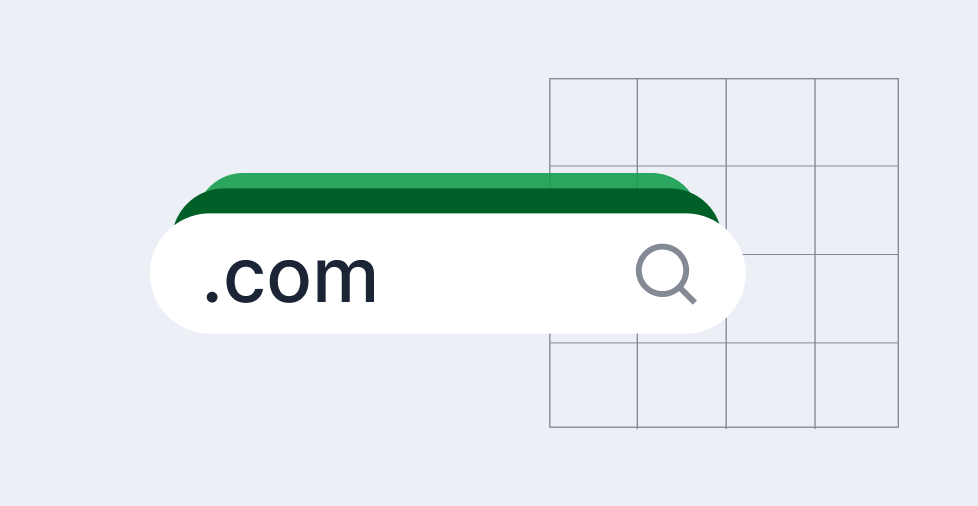Key takeaways:
- The .com top-level domains are the most well-known and recognized extension, with millions of registered domains.
- It can work well for a variety of websites ranging from eCommerce stores to personal blogs.
- Alternatives like .co and .store work for specific purposes if a .com domain isn’t available.
The .com domain name is one of the most well-known and regarded top-level domains (TLD) in 2025, with over hundreds of millions of active websites on the internet. In fact, as of June 2025, the Domain Name Industry Brief cited nearly 160 million .com registrations in the 2nd quarter of 2025 alone.
The .com top-level domains remain the most sought-after domain extensions because of four factors:
- Long-standing recognition
- Perceived trust and credibility
- Universal familiarity
- Strong brand association
Here, you’ll learn about .com, the advantages of using the extension, some alternatives, and how to secure your own .com domain name.
What is .COM?
So, what is .com, and how does it help promote my business on the internet?
The .com top-level domains are the most popular and widely recognized domain extension online. The “.com” stands for “commercial. ” It was originally created in 1985 for businesses and commercial organizations. Over time, it grew beyond its original purpose, becoming the most widespread and recognizable domain suffix. It is the go-to choice for all kinds of websites — from global corporations to personal blogs.
The first .com web address was symbolics.com, registered on March 15, 1985, by Symbolics Inc., a Massachusetts computer company that specialized in computer workstations and programming languages for artificial intelligence research. While Symbolics no longer operates, the domain remains online as an internet landmark.

Verisign currently manages the .com top-level domains. It’s responsible for maintaining the domain registry, ensuring stability, and keeping millions of .com websites accessible. Since taking over in the 1990s, the company has made .com the most secure and reliable domain extension.
Who should use .COM domain name?
The .com extension is an excellent fit for almost anyone. Because it’s the most familiar and widely trusted domain name, people naturally type “.com” in the address bar. That makes it especially valuable if you want your brand to be memorable.
It’s ideal for:
- Businesses and startups
- Personal brands
- Blogs and portfolios
- Ecommerce stores
Businesses and startups
For businesses and startups, trust is everything. A .com domain name instantly signals credibility because it’s the extension people know best. Clients are more likely to click, remember, and return to a .com site than other extensions.
It also gives startups a competitive edge — investors, partners, and clients want results, and it’s easier to build authority from the start with .com. Since many successful global brands use .com, aligning your business with this standard can help you appear more established.
Personal brands
If you’re building a personal brand, a .com domain name helps you stand out and look professional. It makes your name or brand easier to remember, whether you’re a freelancer, content creator, or influencer.
Having a .com also builds credibility with potential clients, employers, or followers who may be discovering you for the first time. Since .com is so widely recognized, it signals that you’re serious about your online presence and makes it simpler for people to find and trust you.
Blogs and portfolios
For blogs and portfolios, a .com domain name makes your work more discoverable and memorable. It also gives your content extra credibility. Whether you’re sharing articles, photography, or design projects, a .com signals professionalism and can help your site feel more established. This is especially helpful if you want to grow your audience, attract collaborations, or even monetize your work in the future.
eCommerce stores
When selling online, trust is key, and a .com domain instantly makes your store look more reliable. Shoppers prefer a site that feels familiar and professional, and .com has that built-in recognition.
Visitors who see your store once are far more likely to remember and return to a .com address than an unfamiliar extension. If you aim to grow sales and build long-term customer loyalty, choosing .com as your generic top-level domain gives your eCommerce site a strong foundation.
Building an eCommerce site shouldn’t be more complicated than riding a bike. Our guide on building an eCommerce store can help you take the training wheels off.
How does a .COM domain name benefit me?
The .com domain name remains the most popular for a reason. It offers several advantages that make it the go-to choice for businesses, creators, and individuals alike:
- Global recognition. People worldwide know and trust .com, making it easier to connect with international audiences.
- Credibility and trust. A .com instantly signals professionalism, which can influence how visitors, clients, or readers perceive you.
- Memorability. Most people default to typing .com. It’s easier for visitors to remember and return to your website.
- SEO value. Search engines don’t favor .com over other domain names. However, its familiarity often leads to higher click-through rates, which can indirectly support your visibility.
- Resale value. Short, brandable .com names are in high demand, giving them substantial long-term value compared to other tlds.
- Universality. The .com works for almost any website, from blogs to global enterprises.
- Email professionalism. A custom email like [email protected] looks more polished than alternatives with lesser-known TLDs.
- User trust in transactions. Customers perceive eCommerce and service-based websites with .com as safer for online payments.
- Proven track record. The domain extension withstood the test of time as the most reliable extension.
- Easier word-of-mouth sharing. Listeners will almost always assume a website ends in .com when someone discusses a website they visited.
Are there downsides to a .COM domain name?
While .com is the most popular domain extension, it comes with a few drawbacks worth considering:
- High competition for names. Established brands have already claimed many short or catchy .com domains, making it harder to find the perfect fit.
- Potentially higher cost. Premium .com names can be expensive compared to newer common TLDs.
- Less availability for niche branding. The .com domain may feel too generic if you want your domain name to reflect your industry.
- Domain squatting issues. Most owned domains sell at inflated prices because .com domains are valuable.
- No built-in SEO advantage. The .com top-level domains alone don’t give a ranking boost in search engines compared to other TLDs, such as country-code TLDs (ccTLDs).
What are the alternatives to a .COM domain?
Is your preferred .com domain owned by someone else? You’re not out of luck yet. Other domain extensions are viable based on your needs:
- .org. Used by nonprofits, charities, and organizations. This TLD carries a sense of trust and community but isn’t always the best fit for businesses.
- .net. Initially meant for network-based companies, the TLD is still common among tech-related pages. However, it doesn’t have the same recognition power as .com.
- .co. Popular with startups because of its short length and availability. The TLD can be an alternative to .com, though some users may accidentally type .com instead.
- Industry-specific TLDs. Great for branding because they instantly show what your site is about.
- Country-code TLDs. Useful if your business mainly serves a local market.
| Extension | Recognition | Trust level | Availability | Best for | Potential drawback |
| .com | Very high | Very high | Limited (many taken) | Businesses, personal brands, ecommerce, blogs | Premium names can be costly |
| .org | High | High | Moderate | Nonprofits, charities, organizations | Less suited for commercial use |
| .net | Moderate | Moderate | Better than .com | Tech companies, networks | Less memorable than .com |
| .co | Growing | Moderate | Good availability | Startups, entrepreneurs | Users may confuse it with .com |
| .store/.tech/.design | Niche-specific | Moderate to high (depends on industry) | High | Industry-specific branding | Less familiar to general audiences |
| ccTLDs (.uk/.ca/.us/.au/etc.) | High locally | High in local markets | High in respective countries | Local businesses and services | Limited global appeal |

How do I register a .COM domain?
You don’t need to be a rocket scientist to register your .com domain. We’ll run down the required steps to help you get started:
- Brainstorm a name. Keep it short, easy to spell, and brandable. Avoid numbers and hyphens if you can.
- Check availability. Use any registrar’s search tool and look for close variants.
- Screen for conflicts. Do a quick trademark and social handle check to avoid legal or branding issues.
- Pick a registrar. Compare renewal pricing, free WHOIS privacy, DNS features, support, and security.
- Add to cart and choose the term. Pick a registration period from one to 10 years. Many owners choose at least 2 years for peace of mind.
- Add WHOIS privacy. Picking the feature hides your contact details from the public registry.
- Create your account and enter accurate contact info. Provide accurate information as ICANN requires valid details for the registrant, admin, and tech contacts.
- Pay and verify your email. Complete the purchase, then click the verification link sent to your email so the domain stays active.
If you want to work with Network Solutions as your domain registrar, our guide on registering a domain will walk you through our specific process and help you purchase your domain in minutes.
Choosing the Right Domain Name with Network Solutions – YouTube
Is .COM right for me?
Choosing a domain depends on your goals, but .com is often the safest bet. If you want global reach, brand credibility, and a name people can easily remember, .com is hard to beat. It works well for almost any type of website — businesses, personal brands, blogs, or online stores.
That said, if your focus is local, industry-specific, or nonprofit-driven, other suffixes like .org, .net, or a country code domain might serve you better.
Build your online brand with .COM
The .com domain remains one of the most recognizable and memorable generic TLDs. It offers numerous benefits, such as increased trust, high resale value, and universal recognition. You can’t go wrong with building a website on the back of a .com extension.
With Network Solutions, we have a huge selection of .com domains to build your website with. Our Domain Name Generator can help you decide on your brand name, and our Website Builder can launch your webpage in a jiffy. Together, we can build you a .com website to help your brand thrive.
Frequently asked questions
It depends. While .com domain is the most recognizable TLD, other top-level domain names might work better for your brand. For instance, .org might work better for charitable organizations.
No, search engines don’t give direct SEO benefits for .com websites. However, most users will likely click on pages with a .com extension.
You can opt to use a different extension. Or you can choose a similar .com domain without an owner. Another option is to check out the domain aftermarket to buy previously owned domains.




